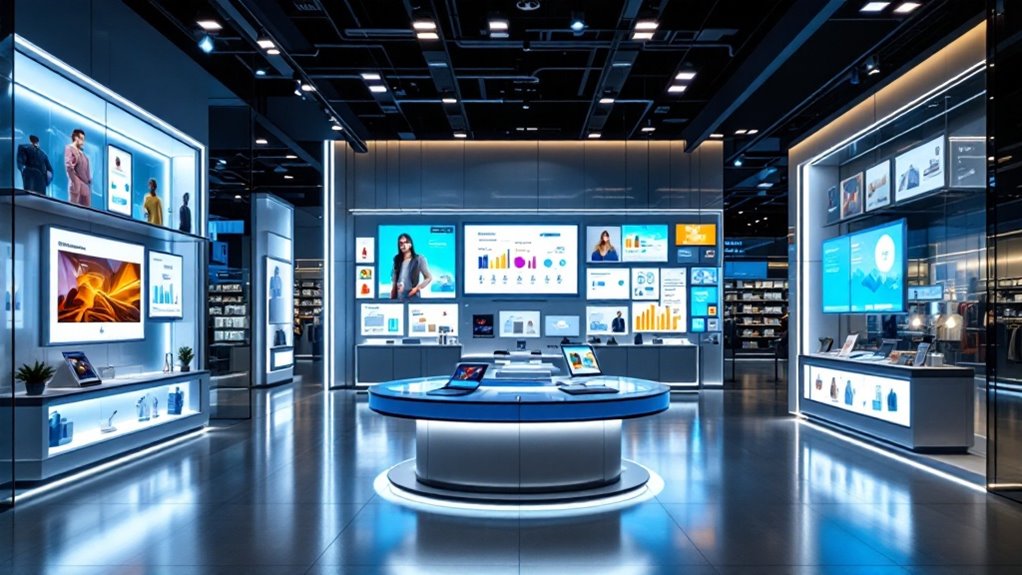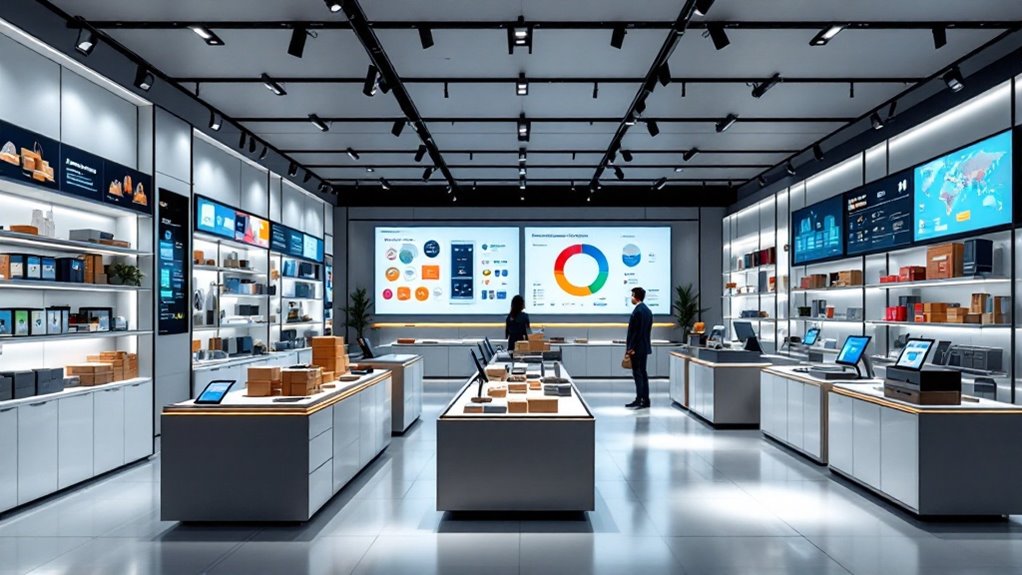Omnichannel ecommerce software unifies retail operations across physical stores, websites, mobile apps, and social media into one seamless system. It centralizes inventory management, customer data, and sales analytics while enabling consistent brand experiences across all shopping channels. Key features include real-time stock tracking, integrated CRM capabilities, and personalized customer engagement tools. Modern platforms leverage AI and AR/VR technology to enhance shopping experiences, boost sales, and improve operational efficiency. Discover how these solutions transform retail businesses into dynamic, customer-centric powerhouses.
Quick Overview
- Omnichannel ecommerce software centralizes inventory management across all sales channels while providing real-time stock tracking and synchronization.
- Integrates essential business systems like CRM, ERP, and POS platforms to create seamless operations and data flow.
- Delivers personalized customer experiences across websites, mobile apps, and physical stores through unified customer data management.
- Provides comprehensive analytics and reporting tools for tracking sales, customer behavior, and performance across all channels.
- Enables consistent pricing, promotions, and brand messaging across all customer touchpoints while supporting features like BOPIS and curbside pickup.
Understanding the Core Elements of Omnichannel Ecommerce Platforms

Modern omnichannel ecommerce platforms unite multiple sales channels through five essential core elements that work together seamlessly. These fundamental components create a cohesive retail ecosystem that serves both businesses and customers effectively.
The first core element is centralized inventory management, which tracks stock levels across all channels in real-time. Retailers can effectively implement features like BOPIS and curbside pickup to enhance customer convenience.
Real-time centralized inventory management ensures accurate stock tracking, enabling seamless cross-channel shopping experiences for modern retailers.
Second, integrated technological systems connect CRM, ERP, and POS platforms for smooth operations.
Third, personalized customer engagement tools deliver tailored experiences based on shopping history and preferences.
Fourth, unified shopping channels guarantee consistent experiences across websites, mobile apps, and physical stores.
Finally, robust analytics and reporting capabilities provide actionable insights for better decision-making and strategy optimization. Together, these elements enable retailers to deliver seamless shopping experiences while maintaining operational efficiency.
Key Benefits for Modern Retail Success
Building on the core elements of omnichannel platforms, retailers who implement these integrated systems gain significant competitive advantages in today’s marketplace. These benefits span across multiple key areas of business operations and customer relationships.
Modern retailers experience enhanced customer engagement through seamless cross-channel experiences, leading to 90% higher customer retention rates. Customer engagement increases by 250% across channels when businesses utilize three or more touchpoints. Revenue generation improves as multichannel shoppers spend 15-30% more than single-channel customers.
Operational efficiency increases through centralized platforms and automated workflows, while inventory management becomes more precise with real-time synchronization across all channels.
Perhaps most importantly, the unified customer data enables retailers to make strategic decisions based on in-depth analytics. This data-driven approach helps businesses understand customer behavior, optimize inventory, and create personalized marketing strategies that drive sustainable growth.
Essential Features That Drive Customer Experience

While successful ecommerce platforms share many common elements, certain essential features stand out as crucial drivers of exceptional customer experience. Modern platforms excel through unified customer data management, facilitating precise personalization across all touchpoints. Advanced CDPs collect real-time information to build detailed customer profiles, while AI-powered tools deliver tailored recommendations and dynamic content. These solutions ensure seamless customer journeys from pre-purchase research through post-sale support.
Effortless multi-channel integration guarantees consistency across digital and physical platforms, with synchronized inventory and order management systems. Interactive features like AI chatbots and AR/VR technology enhance engagement, while sophisticated journey mapping tools help identify and eliminate friction points. The integration of predictive analytics and machine learning algorithms further elevates the shopping experience by anticipating customer needs and automating routine interactions, creating a more intuitive and responsive retail environment. Comprehensive centralized databases enable efficient management of customer information and product data across all sales channels.
Overcoming Implementation Challenges
Despite the powerful capabilities of ecommerce platforms, organizations frequently encounter significant roadblocks during implementation. The primary challenges include unifying fragmented processes, integrating complex technology systems, and managing inventory across multiple channels.
To overcome these obstacles, businesses should focus on three key areas:
- Establish a centralized data management system to guarantee consistent information across all channels
- Implement robust integration protocols between CRM, ERP, and other essential platforms
- Deploy automated inventory tracking solutions for real-time stock visibility
Success also requires addressing customer experience challenges through:
- Unified branding and messaging across all touchpoints
- Synchronized pricing and promotional strategies
- Smooth shifts between online and offline channels
Organizations that methodically tackle these implementation hurdles while maintaining focus on customer needs position themselves for long-term omnichannel success. Companies leveraging AI and machine learning capabilities can significantly enhance personalization and streamline the implementation process. Implementing comprehensive payment processing solutions ensures seamless transactions across various business models and strengthens overall operational efficiency.
Real-World Success Stories and Case Studies

Leading companies across diverse industries have rolled out successful omnichannel strategies, demonstrating the transformative power of integrated ecommerce solutions. Starbucks revolutionized customer engagement by connecting mobile orders with in-store experiences, while Nordstrom unified customer data to deliver personalized shopping across channels. Disney enhanced guest experiences through their thorough app that connects park activities, dining, and accommodations. These businesses showcase how consistent brand identity drives customer trust and recognition across platforms.
Notable success stories include Filling Pieces, which prevented website crashes during high-traffic periods using Shopify’s unified platform. Oh My Cream optimized their operations by streamlining customer flows between online and physical stores. Amazon’s synchronized shopping experience across web, mobile, and Alexa devices exemplifies seamless channel integration. These implementations have consistently shown increased customer loyalty, higher revenue, and improved operational efficiency through unified commerce experiences.
Emerging Technologies Shaping the Future of Omnichannel Retail
Revolutionary technologies are rapidly transforming the landscape of omnichannel retail, creating seamless shopping experiences across digital and physical touchpoints. Modern retailers leverage AI-driven analytics, AR/VR capabilities, and IoT integration to deliver personalized experiences. Cloud and edge computing enable real-time data processing, ensuring smooth operations across channels. Voice assistants are revolutionizing the shopping experience by enabling hands-free product searches and purchases.
| Technology | Primary Benefit | Impact |
|---|---|---|
| AI/ML | Personalized Recommendations | Enhanced Customer Experience |
| AR/VR | Virtual Try-ons | Reduced Returns |
| IoT | Real-time Inventory | Optimized Stock Management |
These emerging technologies work together to create a cohesive shopping ecosystem. AI chatbots provide 24/7 customer support, while AR applications enable virtual product trials. IoT sensors track inventory levels and customer movement patterns, feeding valuable data into analytics systems that drive strategic decision-making. This technological convergence is reshaping retail’s future, making shopping more intuitive and personalized than ever before.
Frequently Asked Questions
How Much Does Omnichannel Ecommerce Software Typically Cost for Small Businesses?
Omnichannel ecommerce software costs typically range from free to several hundred dollars monthly for small businesses. Basic plans start at $50-150 per month, offering essential features like inventory management and basic channel integration.
More extensive solutions cost $300-1,000 monthly, providing advanced features like multi-channel management and automation. Free plans exist but have limited functionality, while starter plans around $100 monthly often suffice for most small businesses’ needs.
What Is the Average Implementation Time for a Complete Omnichannel Solution?
Traditional omnichannel implementations take 1-2 years, highlighting the complexity of these solutions.
However, modern approaches have substantially reduced these timeframes. Complete implementation typically ranges from 6-9 months for small to medium businesses, with some agile solutions offering MVP rollouts in as little as 6 weeks. Factors like existing infrastructure, number of sales channels, and integration requirements can extend or shorten this timeline. Phased implementations often help businesses achieve faster initial results.
Can Omnichannel Software Integrate With Legacy Point-Of-Sale Systems?
Yes, omnichannel software can integrate with legacy POS systems through specialized middleware solutions and APIs. Modern integration methods use cloud-based infrastructure to bridge the gap between old and new systems, enabling real-time data synchronization.
While challenges like compatibility issues and data silos exist, solutions such as standardized protocols and middleware layers help overcome these obstacles. Most legacy POS systems can be successfully connected to omnichannel platforms with proper technical implementation.
How Many Employees Are Needed to Manage Omnichannel Software Effectively?
Like a growing tree that needs the right number of caretakers, the staffing needs for managing omnichannel software vary markedly. A basic setup typically requires 3-5 core team members, including a manager, product specialist, and technical support.
Larger enterprises may need 10-15 employees, adding roles like data analysts and platform specialists. The exact number depends on business size, transaction volume, and system complexity. Small businesses might operate with just 2-3 dedicated staff members.
What Level of Technical Expertise Is Required for Daily Omnichannel Operations?
Daily omnichannel operations require moderate to advanced technical expertise. Staff should be comfortable with CRM systems, inventory management platforms, and basic API functionality.
Key technical skills include:
- Database management and data synchronization
- Digital marketing tools and analytics platforms
- Basic troubleshooting of integration issues
- Understanding of payment gateways
- Familiarity with cloud-based systems
While specialized IT knowledge isn’t always necessary, team members should possess strong digital literacy and adaptability to learn new software systems.
Conclusion
Omnichannel ecommerce software stands as the backbone of modern retail success, weaving together diverse sales channels like threads in a tapestry. As technology evolves and consumer expectations rise, businesses that embrace thorough omnichannel solutions position themselves at the forefront of retail innovation. With the right platform implementation, clear strategy, and continuous adaptation to emerging trends, retailers can create seamless shopping experiences that drive growth and customer loyalty.








